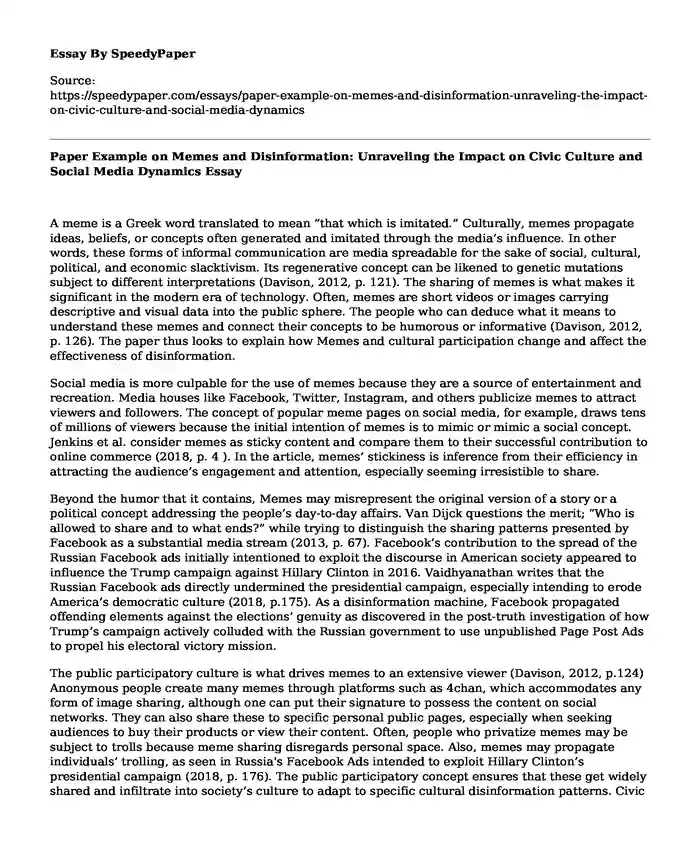
| Type of paper: | Essay |
| Categories: | Culture Communication Social media |
| Pages: | 3 |
| Wordcount: | 727 words |
A meme is a Greek word translated to mean “that which is imitated.” Culturally, memes propagate ideas, beliefs, or concepts often generated and imitated through the media’s influence. In other words, these forms of informal communication are media spreadable for the sake of social, cultural, political, and economic slacktivism. Its regenerative concept can be likened to genetic mutations subject to different interpretations (Davison, 2012, p. 121). The sharing of memes is what makes it significant in the modern era of technology. Often, memes are short videos or images carrying descriptive and visual data into the public sphere. The people who can deduce what it means to understand these memes and connect their concepts to be humorous or informative (Davison, 2012, p. 126). The paper thus looks to explain how Memes and cultural participation change and affect the effectiveness of disinformation.
Social media is more culpable for the use of memes because they are a source of entertainment and recreation. Media houses like Facebook, Twitter, Instagram, and others publicize memes to attract viewers and followers. The concept of popular meme pages on social media, for example, draws tens of millions of viewers because the initial intention of memes is to mimic or mimic a social concept. Jenkins et al. consider memes as sticky content and compare them to their successful contribution to online commerce (2018, p. 4 ). In the article, memes’ stickiness is inference from their efficiency in attracting the audience’s engagement and attention, especially seeming irresistible to share.
Beyond the humor that it contains, Memes may misrepresent the original version of a story or a political concept addressing the people’s day-to-day affairs. Van Dijck questions the merit; “Who is allowed to share and to what ends?” while trying to distinguish the sharing patterns presented by Facebook as a substantial media stream (2013, p. 67). Facebook’s contribution to the spread of the Russian Facebook ads initially intentioned to exploit the discourse in American society appeared to influence the Trump campaign against Hillary Clinton in 2016. Vaidhyanathan writes that the Russian Facebook ads directly undermined the presidential campaign, especially intending to erode America’s democratic culture (2018, p.175). As a disinformation machine, Facebook propagated offending elements against the elections’ genuity as discovered in the post-truth investigation of how Trump’s campaign actively colluded with the Russian government to use unpublished Page Post Ads to propel his electoral victory mission.
The public participatory culture is what drives memes to an extensive viewer (Davison, 2012, p.124) Anonymous people create many memes through platforms such as 4chan, which accommodates any form of image sharing, although one can put their signature to possess the content on social networks. They can also share these to specific personal public pages, especially when seeking audiences to buy their products or view their content. Often, people who privatize memes may be subject to trolls because meme sharing disregards personal space. Also, memes may propagate individuals’ trolling, as seen in Russia's Facebook Ads intended to exploit Hillary Clinton’s presidential campaign (2018, p. 176). The public participatory concept ensures that these get widely shared and infiltrate into society’s culture to adapt to specific cultural disinformation patterns. Civic participation is an eminent cause of the propagation of meaning and the creation of memes.
Memes form an essential stream of communication in our civic culture. The wide use and adaptation create grounds for disinformation and often, faulty clauses of interpretation. Media houses such as Facebook and Twitter propel the broad adoption of memes to attract viewers’ attention and engagement and propagate the culture of sharing memes. Even with public trolls and infiltration of personal spaces, memes continue to attract a participatory cultural influence, propagating disinformation and eroding civic education’s essence. However, it is not to say that these memes propel e-commerce when tailored to meet viewers’ needs and demands.
References
Davison, P. (Ed.). (2012). The Language of Internet Memes. An excerpt from Michael Mandiberg’s The social media reader. Nyu Press, 120-134
Jenkins, H., Ford, S., & Green, J. (2018). Spreadable media: Creating value and meaning in a networked culture (Vol. 15). NYU Press, 1-47
Vaidhyanathan, S. (2018). Antisocial Media: How Facebook disconnects us and undermines democracy. Oxford University Press, 175-195
Van Dijck, J. (2013). The culture of connectivity: A critical history of social media. Oxford University Press, 45-67
Cite this page
Paper Example on Memes and Disinformation: Unraveling the Impact on Civic Culture and Social Media Dynamics. (2024, Jan 18). Retrieved from https://speedypaper.com/essays/paper-example-on-memes-and-disinformation-unraveling-the-impact-on-civic-culture-and-social-media-dynamics
Request Removal
If you are the original author of this essay and no longer wish to have it published on the SpeedyPaper website, please click below to request its removal:
- Free Essay Example on Diversity and Differences
- Free Essay on How It Is Possible to Change the World of Communication
- Essay Sample on a Modern Drama Play by Brian Friel
- Essay Sample on Solutions to the Potential Vulnerabilities in Different Network Systems
- Free Essay. How Social Media Creates Isolation Among Young Teens and Youths
- Integrating Web 2.0 Tools and Social Media - Free Essay Example
- Free Paper Sample on The Power and Perils of Media in Democracy: Strengthening Values and Confronting Fake News
Popular categories




